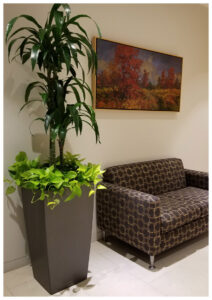
This year COVID-19 has been the driving change in just about every facet of life for people around the world. With many office spaces closing their doors completely in the interest of keeping their teams safe, our community is spending much of their time at home trying best to maintain health and balance in an ever-changing world. But what is left at a busy office space once you remove all the hard-working employees? What has happened to all those beautiful plants that breathed life into the space and created a grounded atmosphere?

Like all of us, our indoor plants are undergoing a transformational time. With few people in office spaces, your office plants are being affected in several ways. Generally, plants are receiving much less light than they were accustomed to. With sensor-activated lights being triggered at a fraction of the frequency that they normally would, and most blinds shut to maintain privacy, plants are having to adjust their speed of growth in relation to the amount of light available. Due to this decreased amount of light, the rate of growth has slowed causing many plants to go into a dormant phase. For indoor plants this can look like dropping leaves, ceasing to put off any new growth, and using less water.
So, what are we doing to help our beloved plant friends through these difficult times? With a keen eye for detail, experienced plant care technicians are paying close attention to the signals that plants send off. When a plant appears to be struggling, adjustments to maintenance practices are made accordingly.
1) If a plant is no longer thriving in a space where it once was, we work to change its location to provide better lighting and/or alter the watering schedules.
2) Watering schedules are being adjusted so that less water is given to each plant, and some plants are watered less-frequently; this helps to maintain a healthy root system and prevent root-rot.
3) We might consider moving a plant closer to a light source, be it a window that receives bright light, or an overhead artificial light in a more trafficked area that is likely to be on most of the time.
4) Pruning office plants and removing any yellowing leaves keeps them looking beautiful. When we do so, we let plants know to put their energy into producing fresh new foliage or blooms. If a particular plant is still having trouble adapting to it’s “new-normal” we will swap it out with something fresh and full.
Just like us, our indoor plants are doing their best to hang-in-there in these trying times. We are busy caring for your plant buddies as they patiently await your return. Contact us if you want to learn more about our interior landscaping services for your office.
